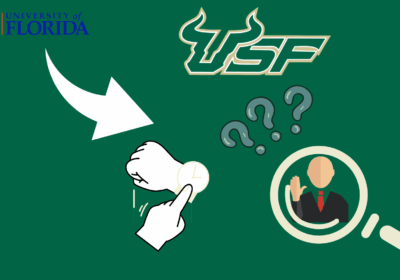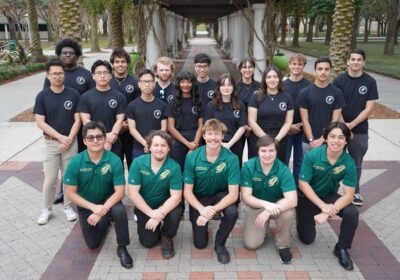Despite preeminence boost, USF loses funding from state

Even with an increase in performance by USF, the school received $7.7 million less from Florida’s Board of Governors in performance-based funding for the 2018-19 academic school year. ORACLE PHOTO/CHAVELI GUZMAN
It became official on June 27: Following year-after-year improvements in performance for the past five years, USF joined the ranks of Florida State University (FSU) and the University of Florida (UF) as the state’s third preeminent university.
Along with the elite status came prestige, as well as an additional $6.15 million bonus in funding from the state to USF. Despite the cash bonus and an increase in performance from the year prior, however, the university still received over $1.5 million less in funding from the state after the Florida Board of Governors (BOG) chopped USF’s performance-based funding by $7.5 million for the 2018-19 academic year.
Without the extra funding, USF Provost Ralph Wilcox says the university may have to scale back on certain one-time purchases for the school at times, such as purchasing new “holdings” for the library, which would include new books, computers, printers, etc.
The loss in funding comes at the same time UF gained $2.5 million more in performance-based funding over the year prior, despite performing two points lower — from a 95 to 93 — on the metrics used by the BOG to judge schools’ performance.
In that same time frame, USF improved its score — which is judged out of 100 — from an 84 to 86.
The reason behind the funding discrepancy can be tricky. The simplest reasoning behind it, according to Wilcox, is that UF, despite its performance decrease, has the largest base budget to begin with. He also says it’s because UF is still the state's top performing university and consistently receives the most funding as a result — receiving $57.6 million to USF’s $37.6 million for the 2018-19 academic year.
But still, why would USF lose funding for increasing its performance, which is judged off of 10 student-success metrics, while its fellow state university earned more for a lesser performance?
According to Wilcox, it’s because USF, which regularly finishes alone in at least third place of the state's top-three universities in performance, failed to do so in the last academic year.
Since the bottom three public universities in Florida receive no performance-based funding from the state, Wilcox says the money that would otherwise go to those schools who finished in the bottom three on the point scale — Florida Gulf Coast, North Florida and FAMU in 2018 — goes to the top-three performers instead.
Coming in a three-way tie with FSU and UWF for third place in performance for the 2017-18 academic year, USF lost its bonus funding after a tiebreaker between the three institutions granted FSU the undisclosed multi-million dollar amount of funding, while USF received no extra money.
“We were disappointed that we didn’t win out, if you will, on some of that distribution,” Wilcox said.
Wilcox says that the method of using the tiebreaker to award one school all of the funds was laid out well before the tie came to be, so the school did not object the method.
Instead, what was more disappointing to Wilcox and the university was that USF was shut out from additional funding despite being designated as an institution that has surpassed the “excellence school benchmark,” while FSU did not, which gave it an advantage USF did not possess.
USF, due to its status as an “excellence school,” cannot reap the benefits of receiving extra points for improvement, but only on how high it performs. Meanwhile, FSU can receive extra points for improving in certain metrics and did so, earning improvement points for increasing its net tuition and fees per 120 credit hours for students.
The BOG judges schools not just on how well they perform, but also on how much certain schools have improved in key areas — such as six-year graduation rate and median wages of bachelors a year after graduation — from one year to the next.
The boost was enough to bring FSU — which finished in fourth the year prior — to being tied with USF and UWF. After the tiebreaker, which judged performance and improvement together, FSU received the bonus, bringing its total performance-based funding, not including its preeminence funding from the state, to $51.6 million.
USF finished second in the tiebreaker.
If schools were judged solely on high performance, Wilcox says, USF would have finished in the top three on its own, eliminating the need for a tiebreaker.
“The disappointment for me was that here you have a university that scored well on the excellence scale (USF) and another university (FSU) who scored well on excellence, but also with a pretty significant point total on at least one of the metrics in improvement,” Wilcox said. “And the excellence school, the school who scored exclusively on the excellent scale (USF), lost out on the tiebreaker. That’s what’s disappointing.”
Despite the disappointment of losing out, Wilcox stressed that USF is not making excuses for itself. Instead, he says, it is ensuring that in the future there’s no need for a tiebreaker to determine whether the school earns a bonus from the state.
The goal for USF this academic year: Earn 89 or 90 points on the metric scale, Wilcox said.
“I think it motivated everyone even more,” Wilcox said. “To ensure we don’t get caught in a tiebreaker in the future. Certainly, we’re not going to be satisfied with anything less than ending up in the top three.”
Still, Wilcox stressed how unpredictable the final standings can be due to how the BOG judge schools based not only on performance, but also off of improvement.
“We’ve seen here and we’ve seen in the past, rather unexpectedly, universities can pop out of nowhere and score well on improvement even though they don’t come anywhere close to the University of South Florida’s performance and be the beneficiary of significant state investments at the expense of USF,” Wilcox said.
“The challenge for us is to keep driving forward and to continue to press upward. Quite clearly, it’s motivated us to roll our sleeves up, to work harder and focus even more on how to improve our performance on these metrics.”







